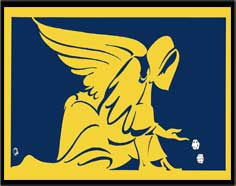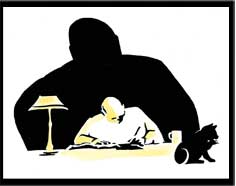Bushrangers were criminals who lived in the bush in the nineteenth century and survived by robbing travellers and other settlers. They had little to do with Sydney directly, but were of immense interest to its residents and sometimes became the subject of political and media debate around the colony, for example over the effectiveness of policing.
Bushrangers often depended on their relatives and friends for supplies, temporary accommodation, and information. Their careers tended to be short and violent, ending when they became so notorious that (as with many urban criminals) the government offered such a large reward for their capture that they were betrayed by former supporters.
There has been considerable romance attached to the bushrangers for many years. In fact they were the rural equivalent of gangsters, most of whose victims were working people travelling the roads on foot. One example were diggers who in a matter of minutes might lose the proceeds of many months back-breaking work in the goldfields, when held up by bushrangers.
Much of this romance derives from Frank Clune’s 1948 book Wild Colonial Boys. It portrayed New South Wales’ most successful bushranger, Ben Hall, as a sort of Robin Hood figure driven to a life of crime largely by police harassment. This popular book had a major impact on views about bushranging for many decades.
In fact, the harassment of Hall followed his initial crimes rather than preceding them, and involved typical police pressure on suspected criminals, their friends and family. Such occasionally brutal techniques are used by police everywhere.
In this case the situation was complicated by the fact that the chief policeman in the hunt for Hall was an English baronet and former Guardsman, Sir Frederick Pottinger, unpopular due to his background and rank with a large section of the ex-convict and Irish population of New South Wales and their representative newspaper, the Empire. In addition, the police force had recently been re-organised, and the courageous but largely unsuccessful Pottinger became the symbol for the teething problems of the new model.

The number of well known bushrangers is relatively small. Little academic attention has been paid to bushranging, and it is still not clear why the most successful bushrangers fell into two fairly tight periods. The first comprised figures including Jack Donahue (shot 1830), Jack the Rammer (shot 1834), John Tennant (hanged 1837), Edward Davis (hanged 1841) and John Lynch (hanged 1842). Relatively little is known about these men and their associates.
In comparison, and thanks to the spread of newspapers across New South Wales, much more is known about the following men, who flourished mainly in the 1860s. One possible explanation for this timing, although it remains speculative, is that the gold rushes meant that by the 1860s there was much more to steal in certain rural areas, while improvements in policing (eg. better equipment, new laws, bigger rewards) brought the bushranging outbreak under control fairly soon.
Dan ‘Mad Dog’ Morgan (1830 – 65)
In 1863 Morgan (not his original name) and an accomplice were involved in a shoot-out with police. Morgan shot his accomplice and escaped while police were tending to his wound.

Thereafter he mainly operated alone, in areas either side of the Victoria-NSW border. In 1864 he held up a sheep station and murdered one worker and wounded two others. He seems to have enjoyed inflicting pain – they had offered no resistance.
Later that year he murdered a policeman for no reason and the NSW government placed a reward of 1,000 pounds on his head. He murdered another policeman, and in 1865 was shot by a worker on a station he held up in Victoria.
Frank Gardiner (1830 – 1903)
Horse thief and hold-up man Gardiner put together the gang of locals who stole 14,000 pounds from the gold escort stage coach at Eugowra near Forbes in 1862, by far the most lucrative of any bushranging venture. Gardiner moved to Rockhampton in Queensland and opened a store, but was recognized two years later, brought back to Sydney and sentenced to 32 years hard labour. Despite this, he was released in 1874 on condition he leave the continent, and subsequently ran the Twilight Saloon in San Francisco.
Two of the farmers Gilbert enlisted for the Eugowra robbery, John Gilbert and Ben Hall, were to become notorious in their own right.
John Gilbert (1842 – 65) and Ben Hall (1837 – 65)
Ben Hall has become notorious as bushranger leader thanks to a book by Frank Clune (see above), but for some of their time together Gilbert was at least his equal in the gang that operated, with changing personnel, for about three years after the Eugowra robbery. They held up travellers, stores, stage coaches, stations and even small towns. (But only one bank – the reason bushrangers held up almost no banks is unknown to us, but sets them apart from their American counterparts.) In 1864 Gilbert murdered one policeman, while the next year their fellow gang member John Dunn murdered another. Part of the romance associated with Hall is that he never killed anyone, although this was probably just a matter of luck.
Gilbert and Hall were killed separately by police in 1865. The government had placed a reward of 1,000 pounds on Hall’s head and he was betrayed by a member of his former support network. Dunn was captured and hanged the next year.
Accounts of Hall in rural newspapers towards the end make interesting reading. (People he stuck up would sometimes give accounts of his conversation to reporters.) He was obviously worn down by the hard life of a bushranger, sleeping rough in the heat and the cold, harassed by flies and mosquitoes, chased by police, and, lacking the resources to quit the life and move to another part of the world. He faced an inevitable early death, whether from gunshot or the noose. There was also the simple loneliness – at times it seems he held up travellers simply in order to have someone to talk to.
Sam Poo (? – 1865)
While not well known, Sam Poo was a curious rarity, a Chinese bushranger and a rapist. Other bushrangers tended to treat women well, partly because to do otherwise would have lost them what popular support they had.
Poo was active around Coonabarabran for only a few weeks, where he raped a settklr’s wife and killed a policeman. He was captured and hanged in 1865.
Thomas (c.1840 – 67) and John (c.1846 – 67) Clarke
The Clarke family in the Braidwood district between Goulburn and the sea were notorious and violent cattle and horse thieves and purveyors of illegal liquor. The family patriarch, an ex-convict, died in prison in 1866 while awaiting trial for murder.
The brothers, along with other family members and friends, robbed hotels, stores, farms, travellers and stage coaches containing gold shipments. Premier Henry Parkes, frustrated by the incompetence of local authorities, appointed four “special constables” led by a senior warder from Darlinghurst prison. They were killed soon after arriving in the Braidwood district in 1867. A regular constable and possibly a member of the gang were among its other victims, making it the most violent of all bushranging groups.
In 1867 Thomas and John Clarke were cornered by police and surrendered, later convicted and hanged.

Frederick ‘Captain Thunderbolt’ Ward (1835 – 70)
Ward was convicted of horse and cattle stealing and imprisoned on Cockatoo Island in Sydney Harbour, from where he escaped in 1863. He had the longest career of any well-known bushranger, operating across northern NSW, alone or with accomplices, until shot by police in 1870. He seems to have chosen the name ‘Captain Thunderbolt’ himself, presumably because it sounded like the name of an English highwayman.
Andrew ‘Captain Moonlite’ Scott (1842 – 80)
After being wounded in the Maori Wars and considering becoming an Anglican priest, Scott began a life of crime largely in Victoria. He probably had a homosexual relationship with colleague James Nesbitt, whom he first met in Melbourne’s Pentridge prison.
Scott did not become a bushranger until 1879. This makes him an outlier in terms of the 1860s period of bushranging in NSW, but he was really a Victorian figure, possibly inspired by the Kelly Gang (1878- 80).
In late 1879, Scott and his colleagues moved into southern NSW and held up a sheep station near Wagga. They terrorized the residents and were eventually surrounded by police at a nearby farmhouse. During the shoot-out, one of the officers was murdered. Nesbitt was also shot and as he lay dying, Scott wept over his body and kissed him. Scott was hanged at Darlinghurst prison.








You must be logged in to post a comment.